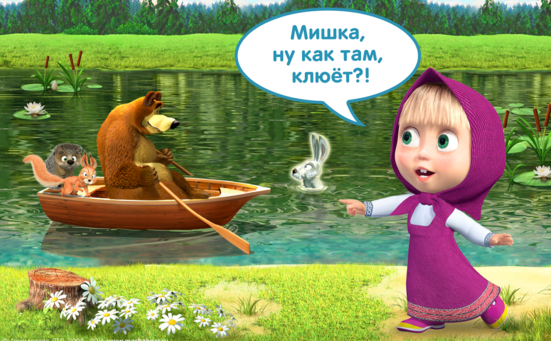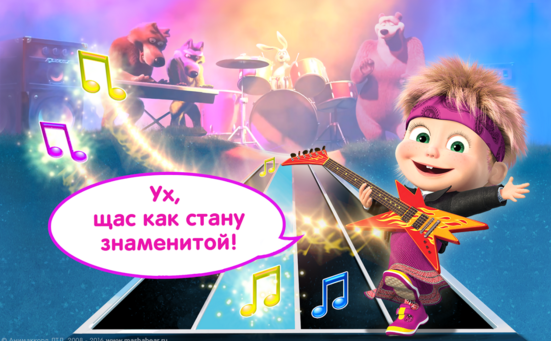Indigo Kids: "The children's market is more complicated than the usual gaming"
The other day, Indigo Kids studio released an update to the mobile children’s game “Masha and the Bear: A Game for Children”. The release turned out to be a great reason for us to talk with Maxim Kochurin, project manager of the company, about the market of children’s applications.

Companies in the children’s games market earn very little. On the verge of payback. What do they live on and why don’t they go to adult gamedev?

Maxim Kochurin
The reason that many do not earn in this market is not in it, but in the developers.
The market for children’s apps is very complex. Many companies don’t understand this. It seems to everyone that it is enough to create something simple for children. They say they are not sophisticated players yet, they say, and so it will do. This is where many novice developers fail.
It is important to understand that the market of children’s apps is a market of increased attention: on the part of parents, on the part of mobile platforms, on the part of the governments of different countries. It has many rules of its own, in which it is very easy to get confused and make mistakes.
And the children’s market itself is more complicated than the usual gaming market.Here we are talking about a more differentiated target audience, whose main aspects of behavior are unknown (the phenomenon of children’s mobile audience is just beginning to be studied by world psychologists), that children have a huge difference in the perception of the same mechanics and images depending on age (4-year-old players and 5-year-old players, for example, often they react quite differently to the same projects).
With the right approach, a high-quality product and the ability to work with the audience, it is quite possible to be a very financially successful company in the market of children’s applications. You don’t have to go far for examples: Toca Boca, Budge Studios, MAGE, Apps Ministry, Indigo Kids.
Yes, you won’t become a Supercell in the market of children’s applications, but this is an excellent market, including for a confident start in the “adult game dev”.

It seems to me that the main thing that helps children’s companies is working with brands. This reduces marketing expenses. The problem is that it is not entirely clear what share the brand plays in the final success.
Using a brand in the game is a double-edged sword.On the one hand, you get excellent organics, styling and recognition in app stores. Brand support makes it possible to quickly reach the top, get a lot of downloads.On the other hand, you pay for it with a percentage of sales. A large percentage.
But downloads still need to be converted into revenue. This is more difficult in the children’s app market than in the adult market.
There is no such thing that most of the purchases fall on the first minutes / hours of the game, which is true for the adult market. Therefore, it is critically important that the game has a good retention.
In children’s games, retention is one of the most important components of success. The length of the session for children’s games is from 3 to 15 minutes, very rarely – half an hour (children get tired faster). They rarely pay in the first session (parents check whether the child will like the game, whether he will remember about it tomorrow).
Advertising does not monetize the game: it will immediately scare the child away. Many do not take this into account, they aim to get downloads. They find themselves in the top, they have millions of downloads, and they suddenly realize that it does not bring money. The main thing here is how we interact with the child in the game, whether he likes it, whether he understands how to play, whether he wants to come back tomorrow.
The issue of monetization in children’s games is controversial. How ethical is this at all?
Monetization of the children’s audience is a matter on the verge of a foul.
For some reason, it seems to everyone that this is unfair to children, although no one asks for free transformers and barbies in the toy store. The game is the same toy and also costs money in production. So for us, the question of “monetize or not” is not worth it.

The fact that we, adults, are pushed to buy at the right moment is no secret to anyone. Besides, we all understand this perfectly. And here we are talking about the manipulation of children. Often, to push them, to manipulate them already adults. Isn’t that right?
If the child plays the game for a long time, if he likes the game, the child goes to the parent to buy the full version. Parents will buy the game either so that the child sticks (if he likes it that way, and mom needs to take him), or if the parent sees that the game develops the child. There’s nothing wrong with that. This is not manipulation. The parent will buy it if he decides to do it himself.
How well do children convert to a paying audience?
You need to understand that children do not pay. Parents pay. They pay little and pay only for proven and really high-quality and useful. The competition is crazy.
If you think you can bring a child to pay and convert – forget it, you are hunting for the wrong one, children are not converted into paying players.
I found a lot of monetization funnels in Masha and the Bear: advertising, buying currency, and even buying the full version. Not too much?
There are several ways to monetize:
- paid version (the easiest way, but not always profitable, is not in trend today);
- free version with the option to buy the full version;
- free version with an internal currency system and its additional purchase;
- demo version with additional purchase to full functionality (additional content);
- free version with ads (banners, videos, etc.).
All these systems have pros and cons.

We have chosen a system that covers the maximum number of monetization paths and in which the player receives the full version without restrictions for the minimum number of IAPs.
The development of children’s applications is a time-consuming and costly process that is difficult to recoup. But there is always a boundary that no developer of mobile children’s apps should cross. Using the advertising monetization model, we personally set up restrictions on the display of non-child ads. It hits revenue, but it’s necessary.
We provide such diversity so that people have a choice.
How are your revenues distributed by type of monetization (i.e. how much does each type of monetization bring to the piggy bank of your projects as a percentage)?
It depends on the application, the country, the advertising format (banner, video, etc.), the profitability of the IAP, the platform. On average, 10% -20% falls on IAP, the rest on advertising. In Russia, unfortunately, they do not really like to pay for a high-quality children’s product. In Europe and the USA, they buy more.
Children are like a game audience: who are they, what do they want, how does their behavior differ from adult players?
There is no concept of such an audience as children. Different ages have different interests in games, psychosomatics, perception, and so on. We have to find a middle ground and aim for it. Our audience is from 3 to 7 years old. Therefore, our games have three difficulty levels for children: from 3-4, 5-6, 7 and above.
If you are making a game for children, what moments do you need to constantly remember? They say, without what the children’s game will not go at all?
Children of different ages have different knowledge (counting, reading, and so on). Children are very easily distracted, get tired quickly.

Games should have a lot of graphics, associative pictures, because children do not perceive texts. Their motor skills are weaker, as is their reaction, so the objects on the screen should be larger.
They learn and progress very quickly, unlike adults. Therefore, it is important to make games with difficulty levels for them.
In games for children, it is important that there be voice acting, cool characters with whom there will be an emotional connection, an understandable response to any action. If the child pressed the wrong button, they should explain to him what happened, there should be sound, animation, graphics for feedback. The effects, even if they are “collective farm” cycles, should explain whether the player did the right thing or not. The more effects, the better. Passed the level – here are the stars and fireworks for you.
Do not forget, children do not pay, it should be clear and interesting for them to play.
Then there will be paying parents for you.
I see! Thanks for the interview!